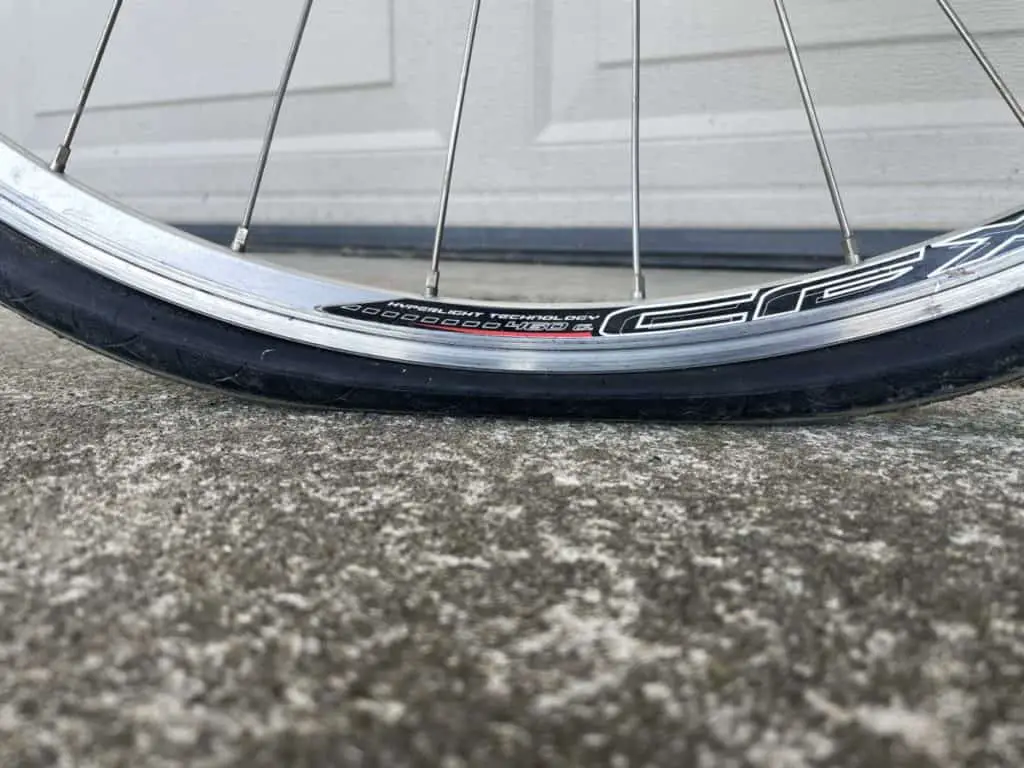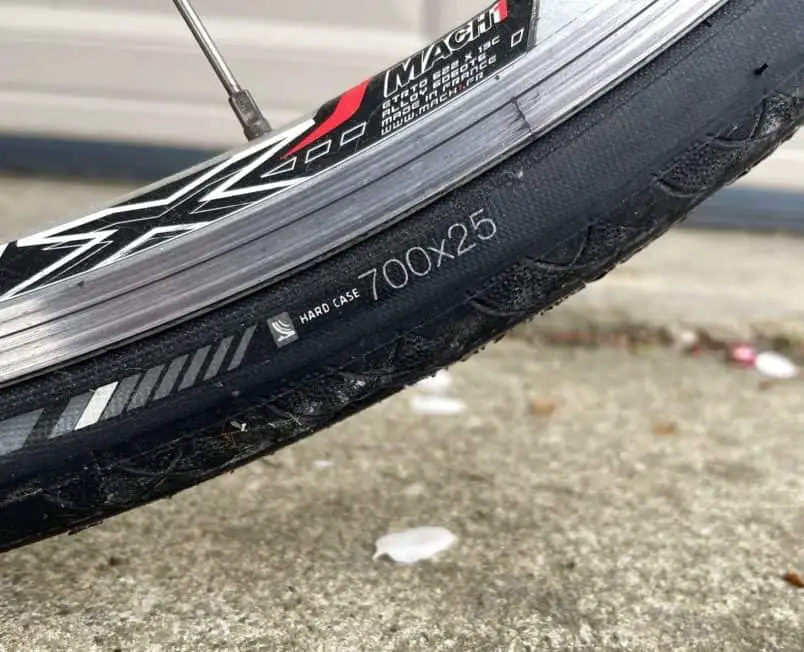There are plenty of ways a tire can go flat, but does it seem to happen more often on your road bike? If you find yourself getting a lot of flats on your road bike and don’t understand why, read on!
Why Road Bike Tires Get More Flats
Road bike tires get more flats because they’re not as durable as mountain or hybrid bike tires. Road bike tires have an average lifespan of 1,000-3,000 miles, whereas other tires can last longer. They’re also designed to be thin and light…great for speed and efficiency, not so great for durability.

Although road tires may not be the most durable tire out there, getting flats should not be a frequent event. If your road bike is consistently getting flats, there are a few different things that could be causing this issue:
1. Tire is Underinflated
An underinflated tire is a major cause of flats for road bikes.
Road tires should typically be inflated somewhere between 90-130 PSI. But when your tire pressure is too low, it is vulnerable to pinch flats and blowouts.
Pinch flats are a common consequence of low tire pressure. When your tire pressure is too low your inner tube can get squeezed between the tire and your rim. If you’re riding on very hard uneven surfaces or hit a sharp edge like a curb, this can cause your tube to pop.
Your tire is also vulnerable to blowouts when underinflated. When the air pressure in your tire is too low, more of the tire will be in contact with the ground. This causes a buildup of heat and friction on the tire. Once the temperature increases too much, the tube expands and the tire can rupture.
2. Tire is Overinflated
An overinflated tire can also cause punctures and blowouts.
An overinflated tire is more prone to punctures. Think of it like when you overinflate a balloon. With an overinflated balloon, the slightest amount of extra pressure will cause it to burst. When a balloon is not as inflated, it’s much more pliable: you can squeeze it much harder without risk of it popping.
Bike tires are the same way. When your tire is overinflated, any additional pressure (like hitting a rock or riding off a curb) risks causing your tire to burst.
3. Road Debris
Glass, nails, bits of plastic, wire, and other sharp objects are common obstacles for road cyclists. Waste like this is not as common on mountain bike trails, but unfortunately is plentiful on the roads.
Being able to watch where you’re going and dodge potential tire killers is an important skill for road cyclists. There is plenty of litter and debris on the roads, which makes trash one of the top causes of road bike flats.
Road Bike Tires vs. Mountain Bike Tires

So what makes road tires so different (and less durable) than mountain bike tires? Here are some major differences between the two:
1. Design
Road bikes are designed for speed and mountain bikes are designed for durability.
A mountain bike is made for rough riding, and so are the tires. Mountain bike tires are big and bulky. They need to be able to handle steep descents, big jumps, and rough landings. Their design allows them to roll over rocks and through mud, gravel, sand, and other rough terrain with ease.
Road bike tires on the other hand are not designed for such terrain. These tires are made to get you very far, very fast. But their lighter design makes them less capable of handling rough terrain. They may be faster and lighter than mountain bike tires, but mountain bike tires are much more durable.
2. Lifespan
Mountain bike tires have a greater lifespan than road bike tires. They are made of much thicker rubber to protect them from the rigors of rough trail riding, and should last more than 3,000 miles. Of course, this is greatly dependent on how aggressively you ride as well as the type of trails you ride on.
Road bikes on the other hand have an average lifespan of just 1,000-3,000 miles.
3. Terrain
Mountain bikes and road bikes are designed to be used on very different terrain. You could ride a road bike on some trails or a mountain bike on the road, but neither will perform as well as they would in their own element.
Mountain bike tires can shred through mud, dirt, and gravel. They perform very well on rough terrain because they’re specifically designed for it: they’re much wider and have grippy knobs for added traction in soft dirt. However, these qualities would make them rather sluggish on the road.
A road tire on a paved road performs incredibly well. A thin tire has less contact with the road, which reduces friction and increases speed. But on a mountain bike trail, thin, low-profile road tires will not offer enough traction, grip or high-speed cornering ability.
Both types of tires are designed to be the best at tackling specific terrain…which is why they really shouldn’t be used on terrain they were not intended for.
8 Tips for Preventing Road Bike Flats
1. Use Talcum Powder
Talcum powder helps reduce friction between your inner tube and tire.
Using talcum powder on a new inner tube prevents the tire and tube from sticking to each other. If your inner tube and tire are sticking together during a ride, the friction between them could wear a hole in either.
Powdering your inner tube prevents unwanted “chafing” and increases your tube’s lifespan.
2. Check Your Tire Pressure
Both underinflated and overinflated tires cause flats. It is important to keep an eye on your tire pressure and make sure it’s not too low or too high.
Get into the habit of always checking your tire pressure before you ride. Don’t wait until you’re on the road and get a flat.
3. Use Tubeless Tires
Tubeless tires are more flat-resistant than tires with tubes. Tubeless tires are designed to be puncture-resistant. Not only do they have thicker sidewalls, but they’re filled with a tire sealant that repairs minor punctures from the inside before they can deflate your tires completely.
And without tubes, pinch flats become a thing of the past…you can’t pinch your inner tube between the tire and rim if it isn’t there to begin with!
You can also run slightly lower tire pressure in tubeless tires, which reduces the risks associated with an overinflated tire.
4. Use Rim Tape & Tire Liner
Rim tape and tire liners help prevent damage to your inner tube.
Rim tape lines your rim and protects your inner tube from being punctured by spokes, spoke holes and any sharp edges on your rim. Using durable rim tape and applying it correctly can save you from a lot of flats.
A tire liner is a strip of plastic that lays between the inner tube and the tire. This extra layer of protection can greatly reduce the chance of flats caused by road debris or striking sharp obstacles.
5. Inspect Your Tires Regularly
It is not uncommon for a puncture to go unnoticed. Getting into the habit of inspecting your tires will help you catch any punctures or defects before your tire goes flat. Even if you don’t see any punctures, you may notice significant wear: a sign that you’re bound for a flat in the near future.
Look for signs like a worn-down tread, cracked rubber, or uneven shape. These will let you know it’s time to buy some new tires.
6. Replace Your Tires
Tires do get worn and can deflate over time.
If you’ve inspected your tires and they look pretty worn out, it would be a good time to consider replacing them before a rupture occurs. A flat tire anytime is annoying, but at the wrong time it could lead to a crash and potential injury.
It’s better to replace your tires before this happens.
7. Be Conscious of Where You’re Riding
Road bikes are not made exclusively for pavement: they can withstand potholes, cobblestone, and dirt roads. But there are some environments where you are more likely to get a flat than others. These tires are not designed for mountain biking trails and should not be used here.
Not only will it significantly reduce your tires’ lifespan, but it could result in an injury: road tires do not provide enough traction or stability to handle the needs of rougher terrain.
8. Invest In Sturdier Tires
If you are experiencing frequent flats with the tires you use it may be time to invest in a better brand. Thin, light tires may be faster and more efficient, but if you’re a more aggressive or heavier rider, it’s worth sacrificing a little bit of speed for more durability and support.
More robust tires are more expensive, but you’ll end up replacing cheap tires more frequently than high-quality tires, so in the long run it’s a better investment.
